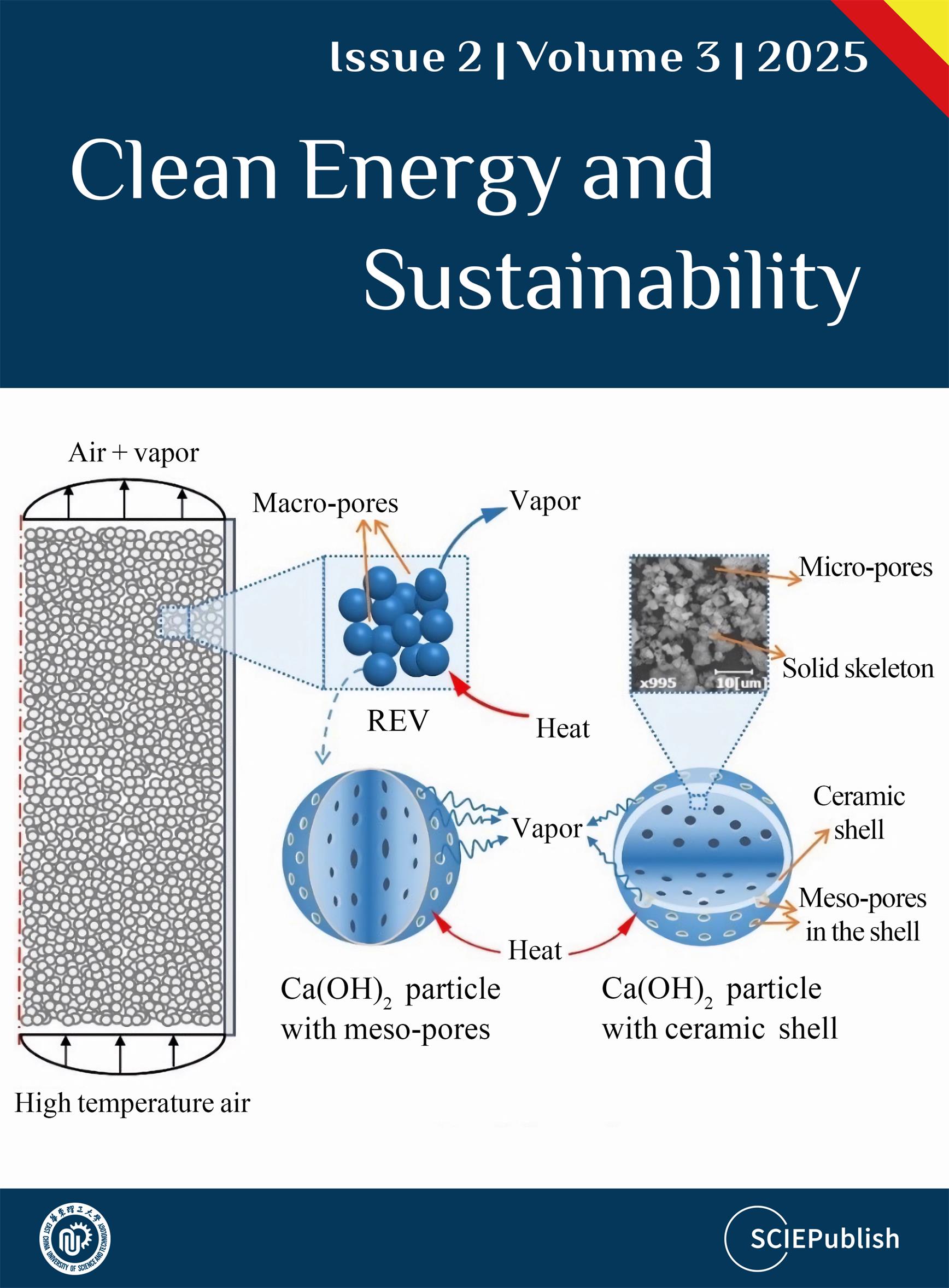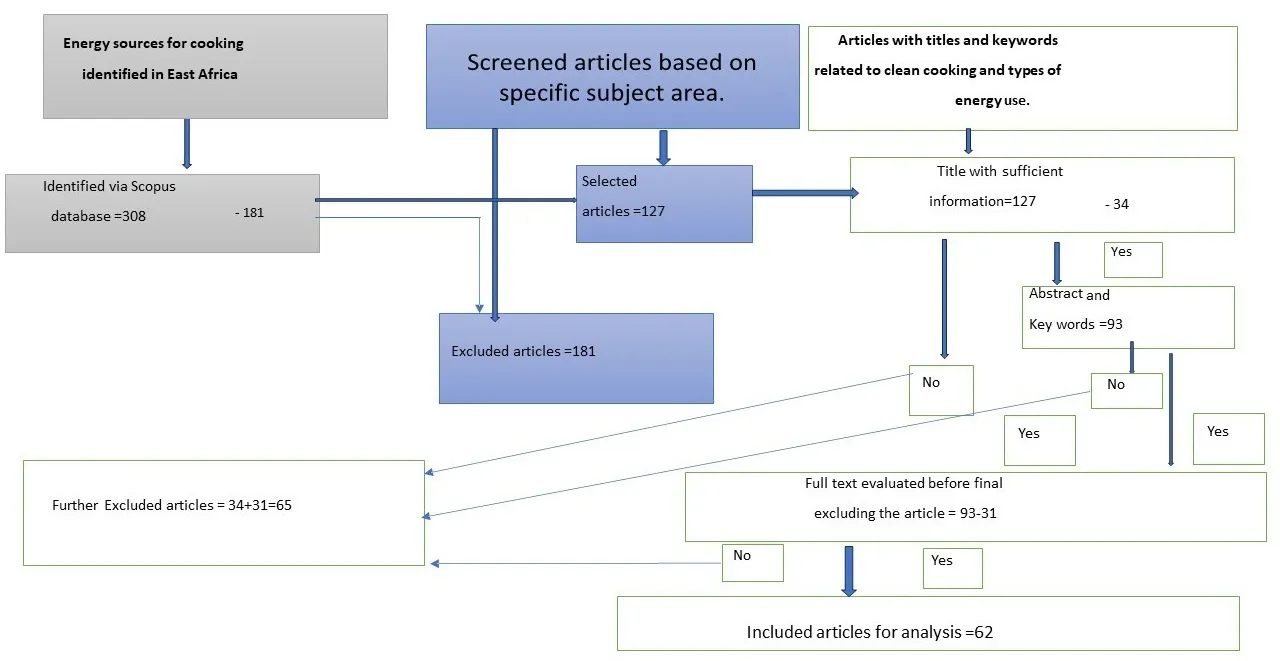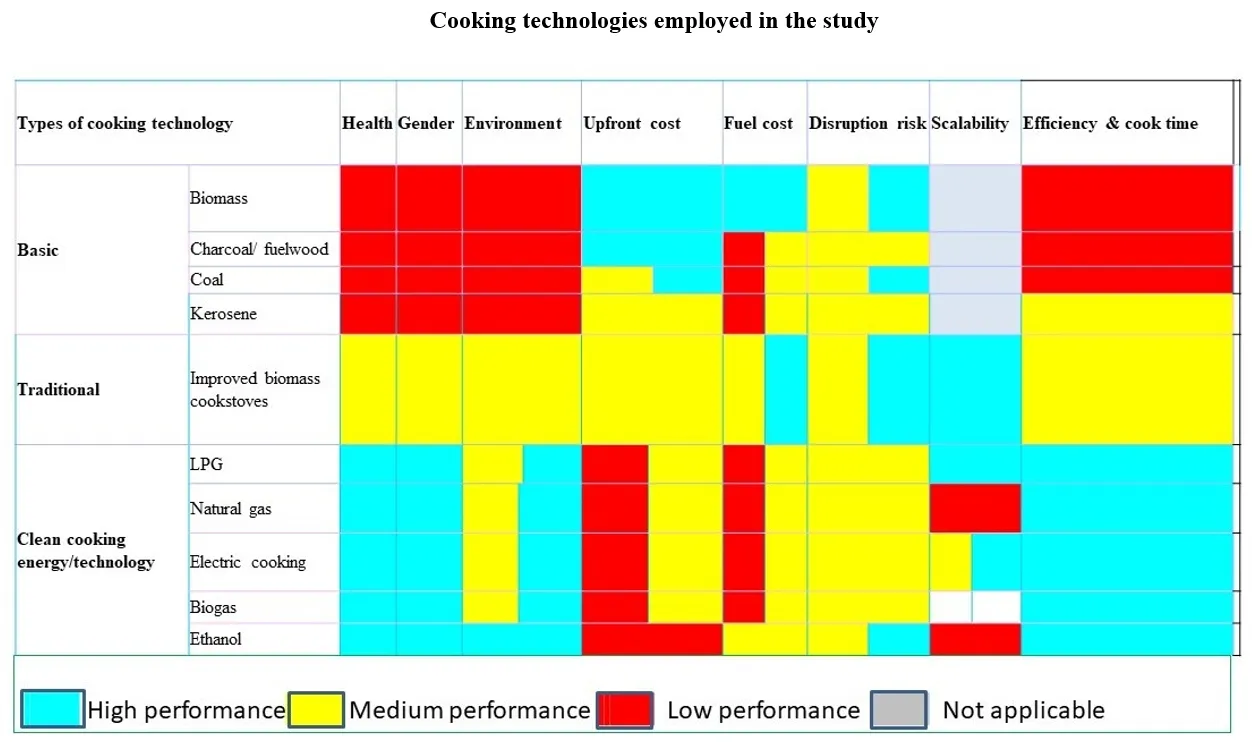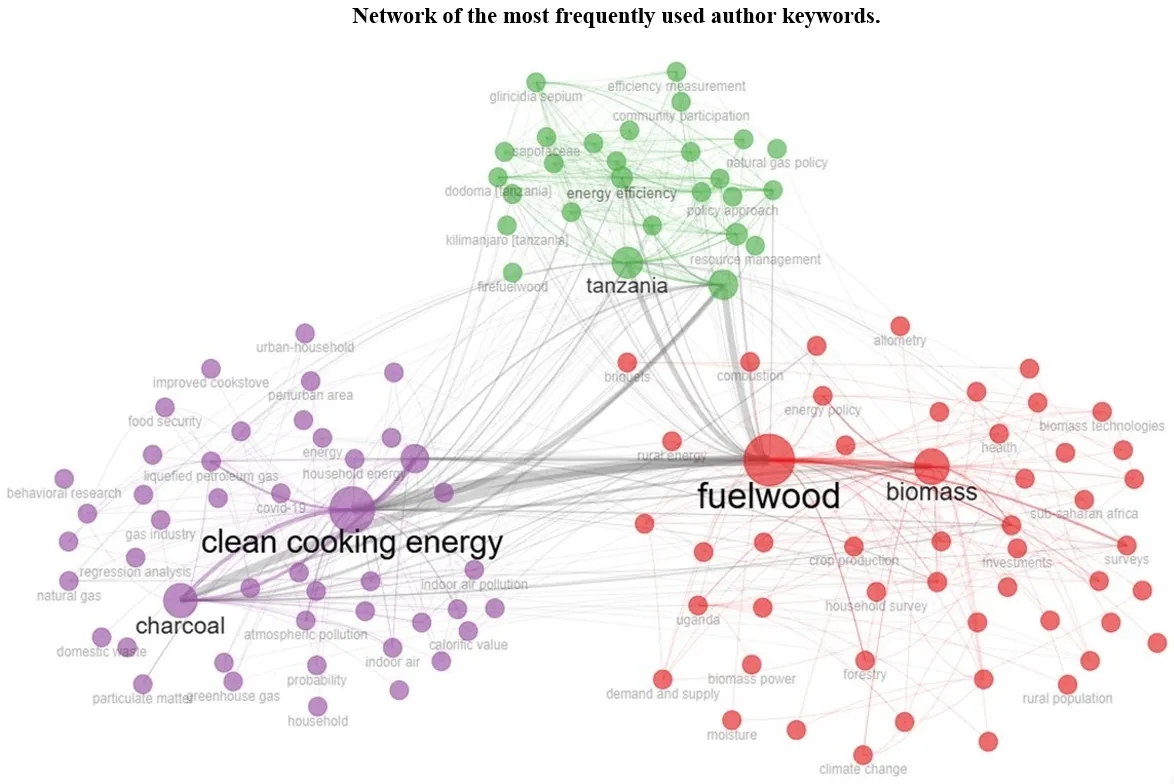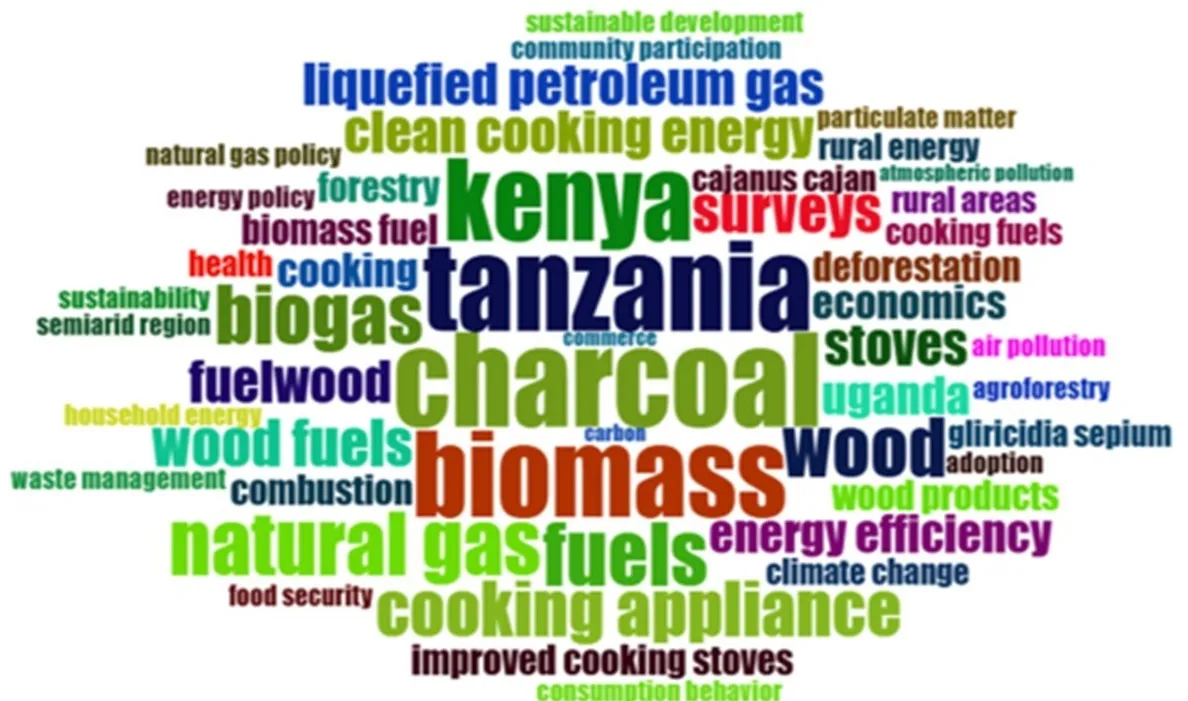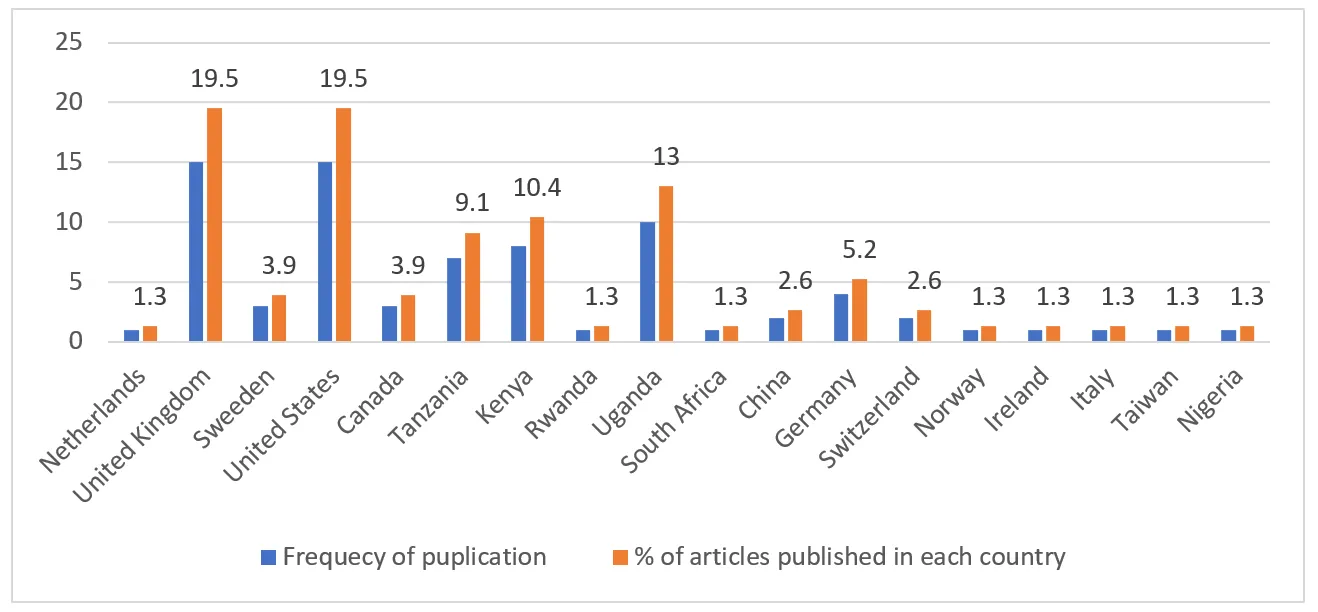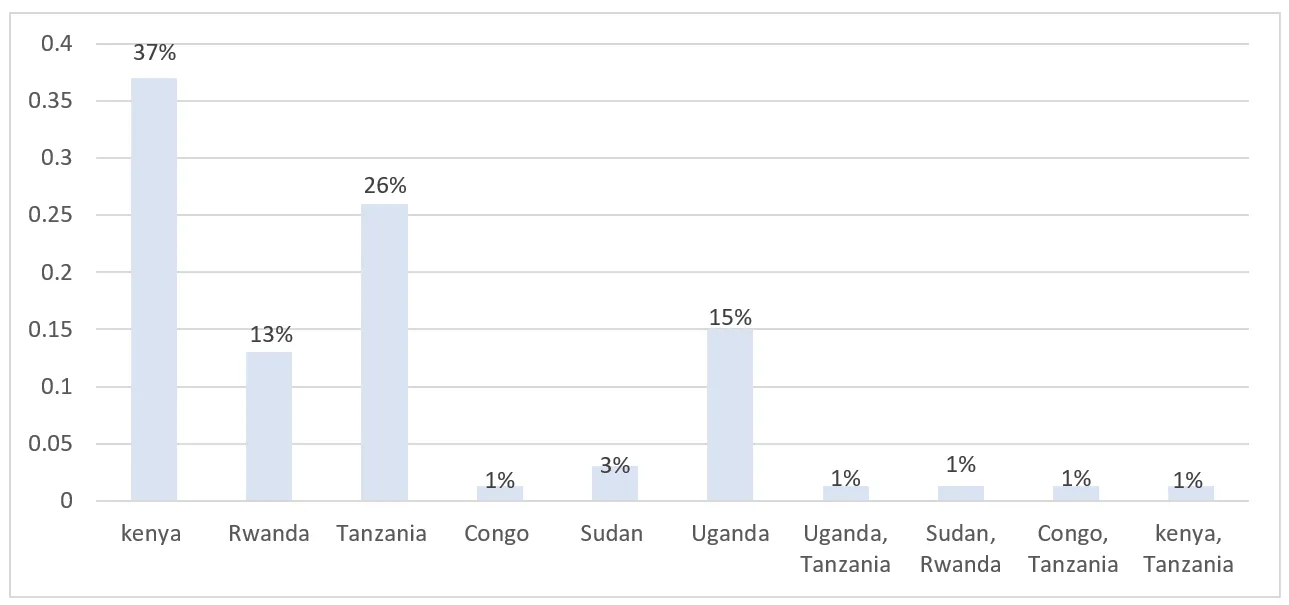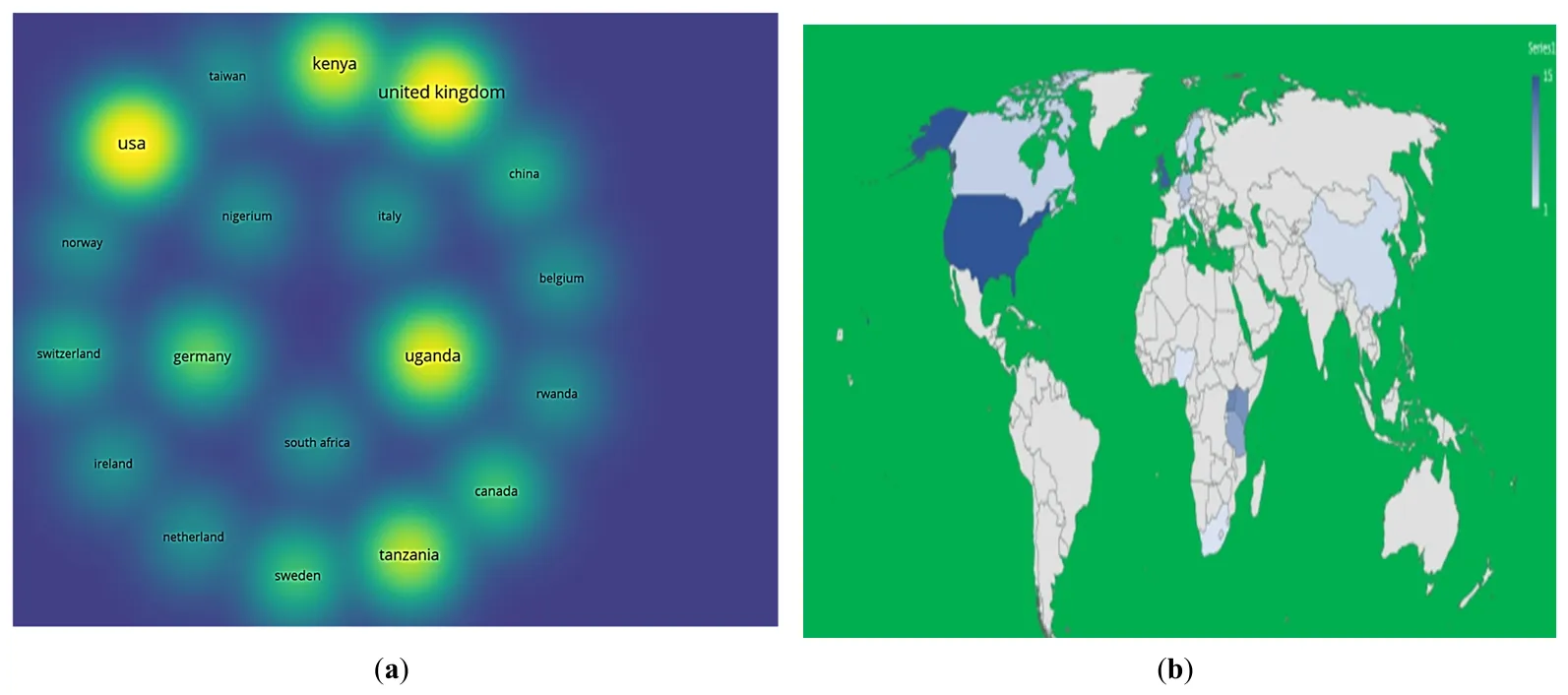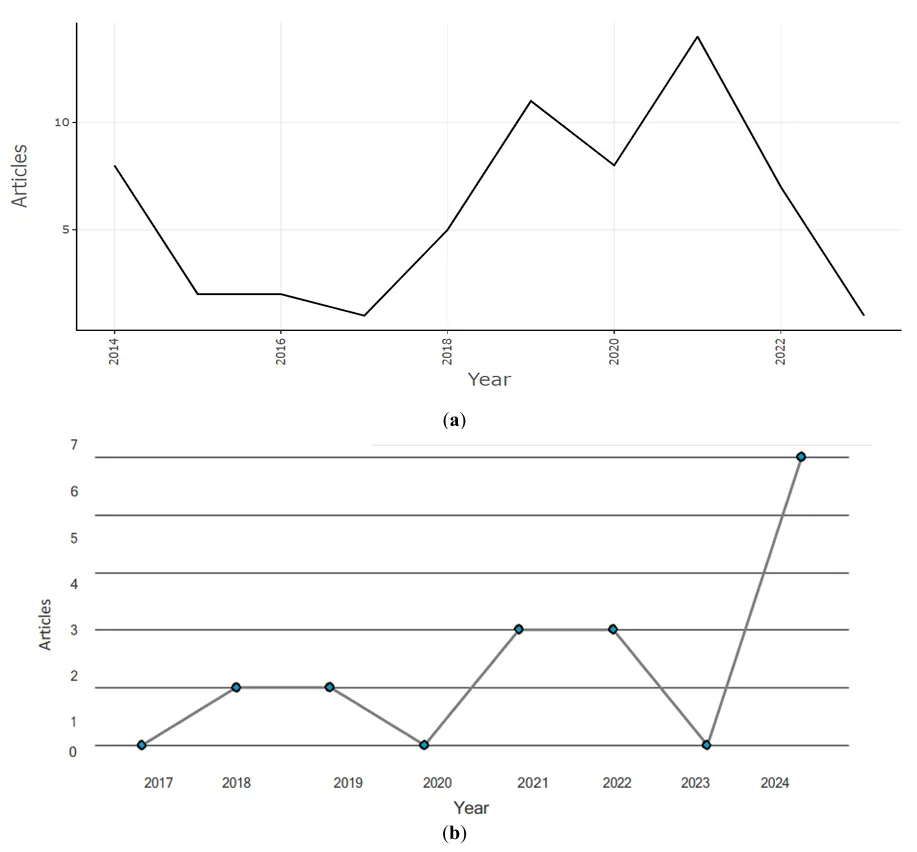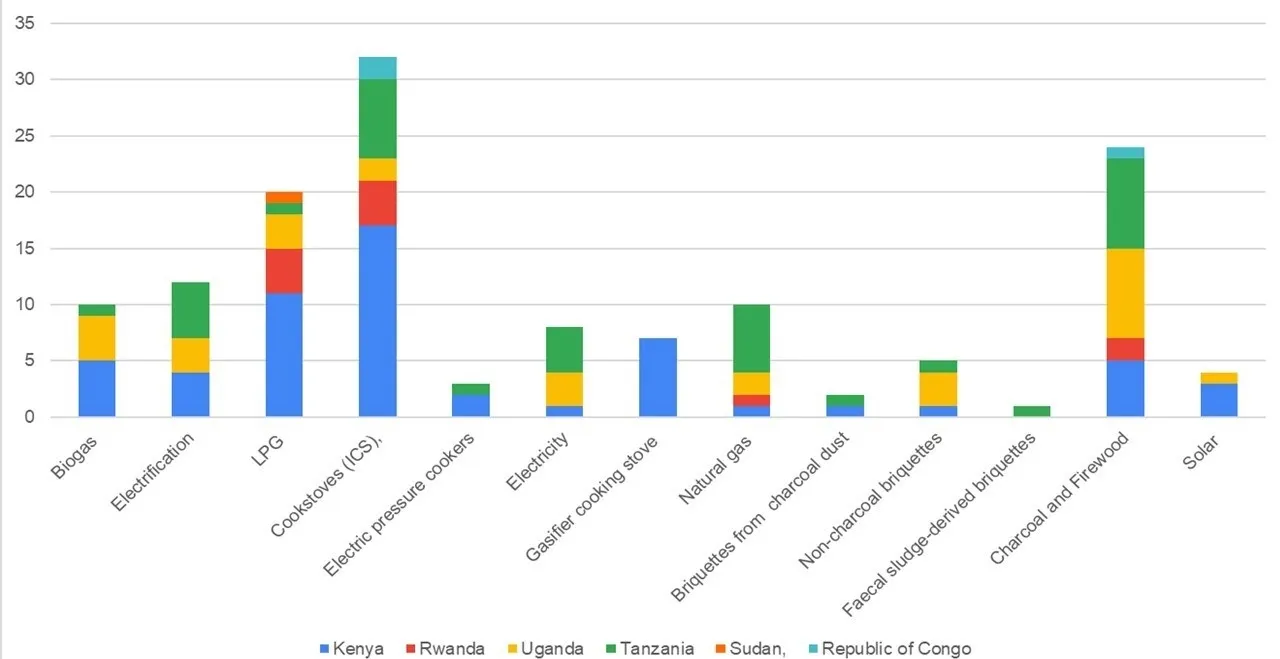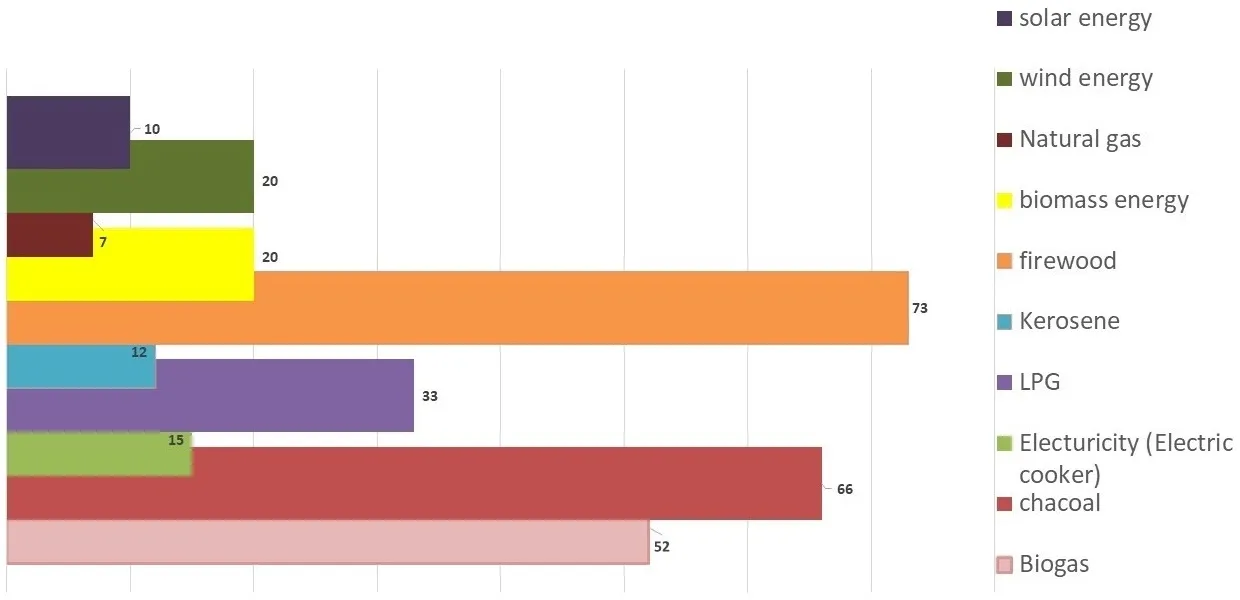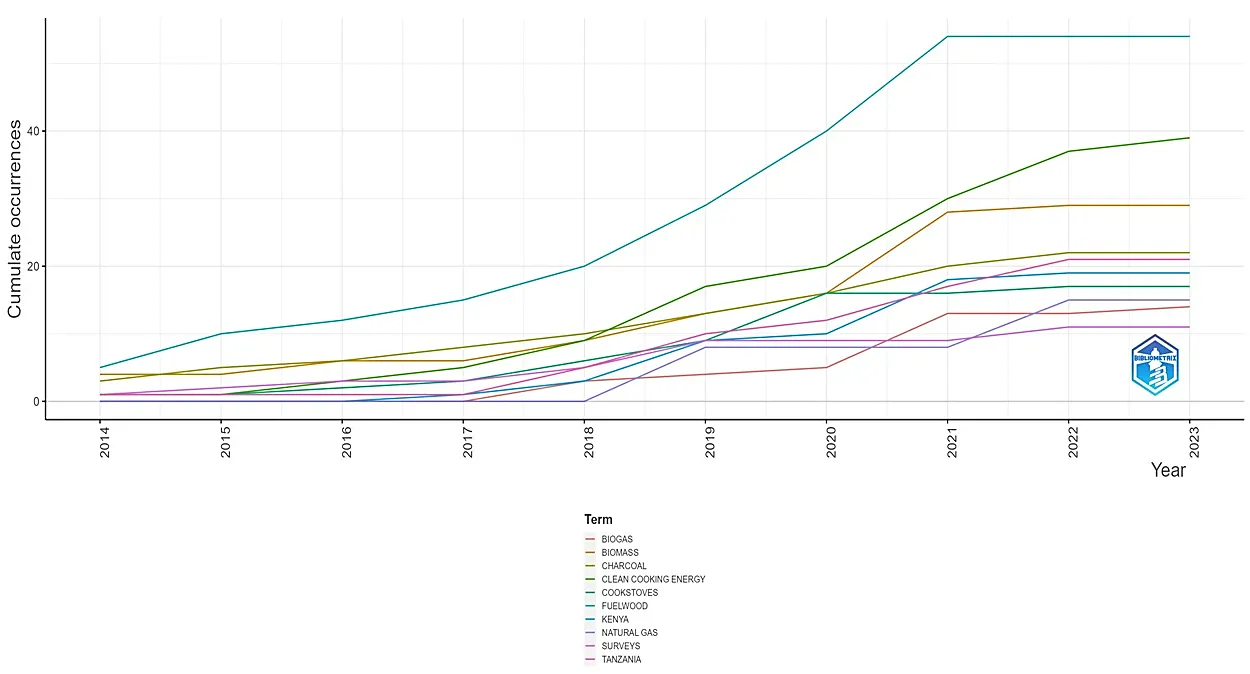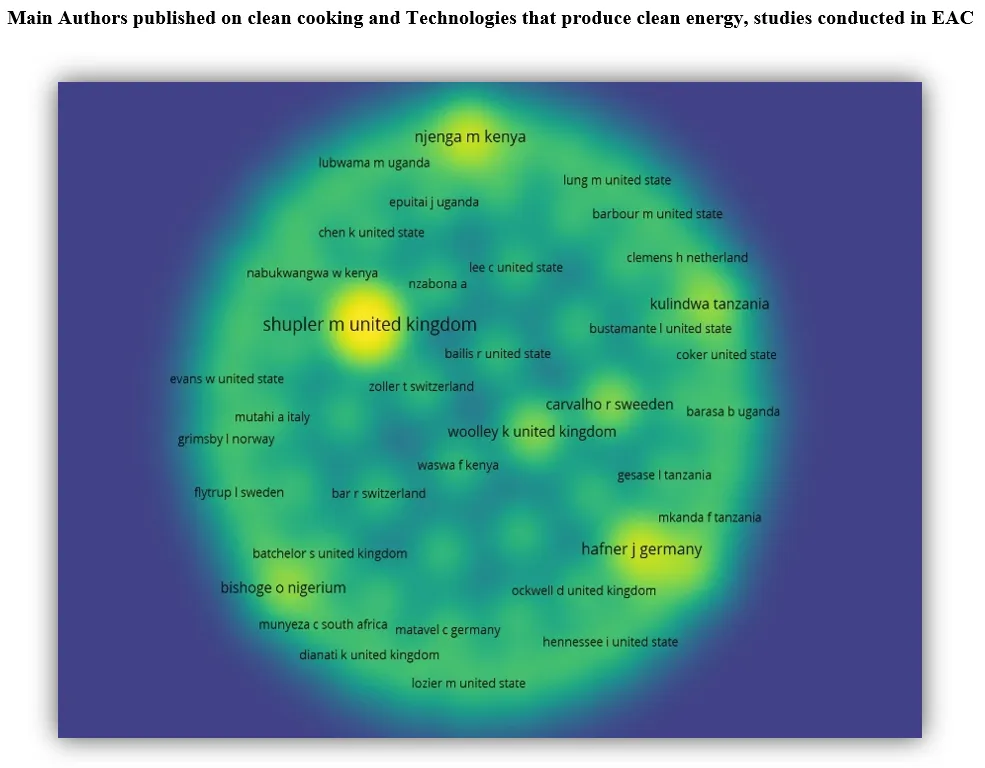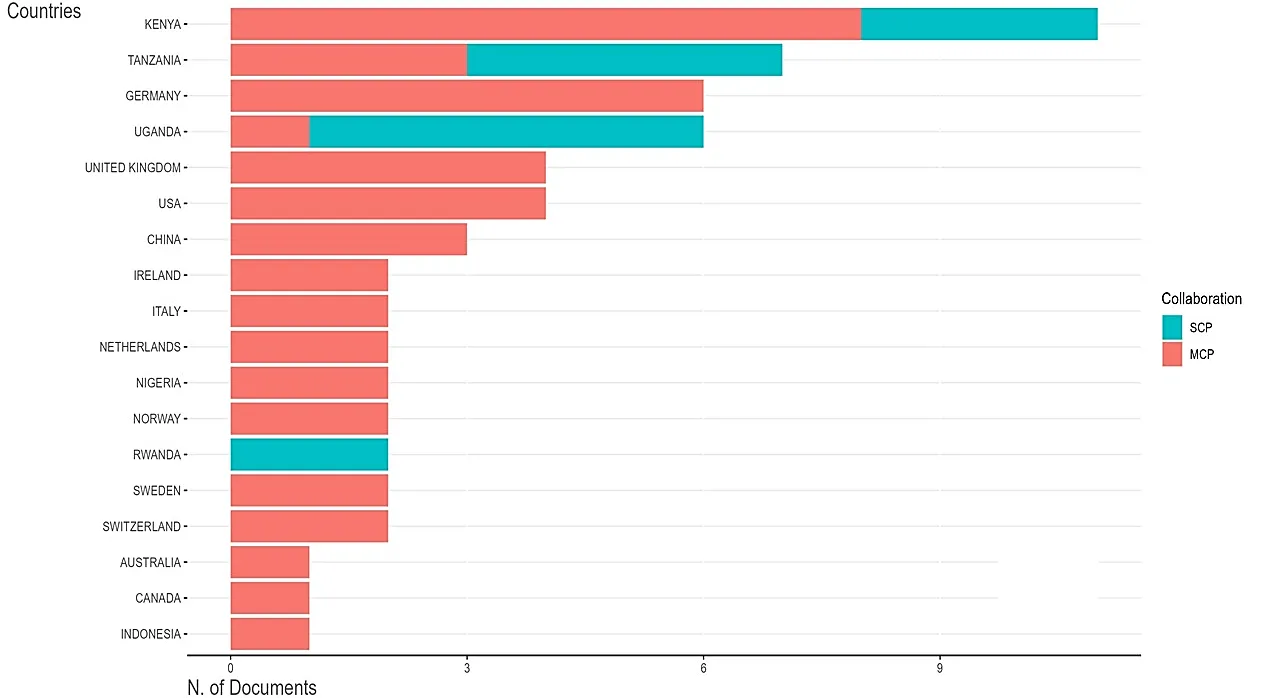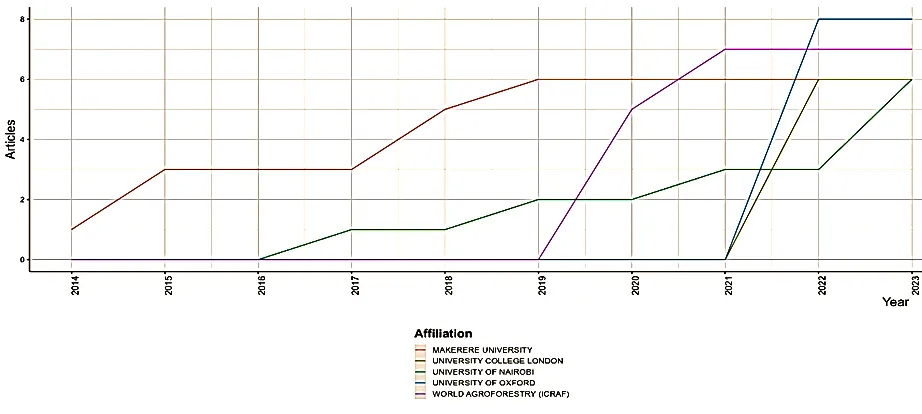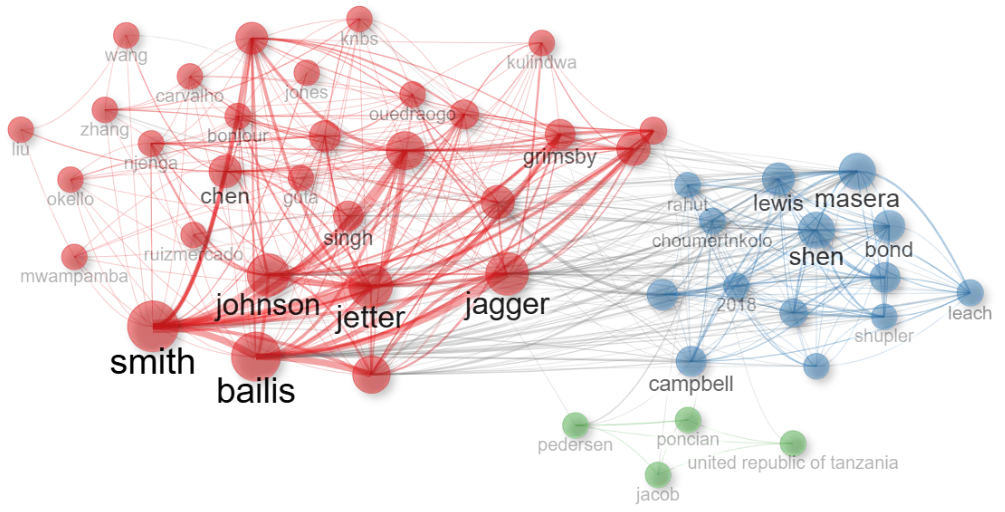Download PDF
Cite This Article
Contents
A Systematic Review of Clean Cooking and to Whom Does the Clean Cooking Agenda Belong? Empirical Evidence from East African Community
Yusuph J. Kulindwa
1,2,*


Author Information
Other Information
1
School of Business, Economics and Management, University of Lusaka, P.O. BOX 367111, Lusaka 10101, Zambia
2
Department of Economics and Statistics, Moshi Co-Operative University, P.O. BOX 474, Moshi 25121, Tanzania
*
Authors to whom correspondence should be addressed.
Received: 15 April 2025 Revised: 30 April 2025 Accepted: 16 June 2025 Published: 23 June 2025
© 2025 The authors. This is an open access article under the Creative Commons Attribution 4.0 International License (https://creativecommons.org/licenses/by/4.0/).
Clean Energy Sustain.
2025,
3(2), 10006;
DOI: 10.70322/ces.2025.10006
ABSTRACT:
Today,
about three billion people, including those in Tanzania, still cook using
traditional methods and solid fuels. This practice, which primarily affects
women and children who cook in many developing nations, contributes to serious
health risks and forest degradation. Every year, household air pollution is
responsible for over 34.4 million preventable deaths worldwide, with about
346,600 of those deaths occurring in East African Community and the Nile Basin.
Even though switching to clean cooking technologies is a global health
priority, adoption is still low in the East African community, and little is
known about the factors influencing this change. To determine the factors
driving East Africa’s energy transition to clean cooking, this study conducts a
systematic review and looks at the history of the research agenda. A total of
308 articles were found using the Scopus database; 62 of these were chosen for
analysis based on important search terms such as solar, biogas, firewood,
charcoal, LPG, and electric stoves. Even though traditional fuels continue to
be the most commonly used in the regions, the empirical analysis showed a focus
on clean cooking technologies like electricity, improved cookstoves, and LPG.
The clean cooking agenda appears to be primarily externally driven by European
and USA researchers, which may have an impact on local adoption and relevance.
It is noteworthy that authors from outside the region constituted 63.6 percent
of publications on clean cooking in the East African Community.
Keywords:
Wood
energy; Clean
energy; Cooking
stove; Clean cooking agenda
1. Introduction
About 90% of the primary energy in households, where 60–80% of households use firewood as the main source of cooking and 25–30% use charcoal [1,2]. Remain shares of 5% LPG, 3% Electricity, and the remaining 2% use other alternative energy such as biogas. The use of traditional fuel and wood fuel stoves contributes to a range of adverse health impacts, especially for women and children, because women are traditionally responsible for the time-consuming task of fuelwood collection. The use of traditional fuel and wood fuel stoves has a number of negative health consequences, particularly for women and children in their homes, because women are still traditionally responsible for cooking in developing countries [3,4]. Globally, there are over 3.4 million estimated premature deaths due to household air pollution [5] and 346,600 deaths in East African Community (EAC) and Nile Basin countries.
As we pointed out, women are traditionally responsible for fuelwood collection. We intend to eliminate the need for women to carry strenuous loads of firewood on their heads and promote a clean cooking environment. However, adoption remains low, and the drivers of adopting clean cooking practices are not well understood in the East African Community. Some political leaders admit that there is insufficient research and innovation in Africa, as Tanzania President Samia Suluhu Hassan cited as an example [6]. However, there has been limited success in adopting clean cooking technology, highlighting the challenges of energy transition from traditional fuel practices to clean energy [7,8].
Several studies have demonstrated that women carry loads of firewood on their heads to meet their cooking obligations. This reflects the laborious and time-consuming process of gathering fuelwood, which is usually done by women in EAC and developing countries [9]. Following the gathering of firewood, the woman cooks using traditional techniques, which leads to coughing and crying while cooking through burning the firewood.
This usually represents an “unclean cooking practice” that leads to household air pollution. Studies further note that this type of cooking can lead to health problems, particularly for women and children [10].
To mitigate the effects of low adoption of clean cooking practices, it is critical to change traditional cooking behaviors, use cleaner energy sources, and reduce or eliminate the use of wood fuel. However, studies inform that the gender imbalance in the energy sector is partly and does not encourage women to be involved in clean cooking technology adoption [11,12]. Few studies on clean cooking have been conducted in EAC, and even among those few studies, it is not known exactly who financially supports them as viable studies. The question remains unanswered: who owns the clean cooking agenda between East African community government officials and non-East African authorities? As a result, if the agenda originates outside of EAC, the energy types and technologies most commonly used in the study may not be relevant to East African community countries.
Given the above arguments and the low adoption of clean cooking technology, current research on clean cooking practices in East African Community countries calls for analysis to determine who supports them. It is likely that if countries own the clean cooking agenda, they would influence what types of intended clean energy are to be imposed based on the environment and community purchasing power and would be able to change household cooking practices unless the agenda comes from outside a particular country [13]. As a result, if the agenda comes from outside the country or region, in this case, outside EAC, the energy types and technologies most commonly used in the study areas may not be relevant to such countries, leading to low adoption. In this regard, the adoption and sustained use of clean cooking technologies may not be realized.
We argue that there have been few, if any, published articles that have assessed funders of articles about cooking practices and behavior, claiming that they have not been thoroughly studied published articles on clean cooking to understand the supporters and, thus, be able to meet the region’s interests where necessary. Furthermore, we maintain that published articles may not clearly outline and explore the critical issues or energy types confronting the region in changing traditional cooking practices if not funded by local institutions or their own countries.
In line with the international research efforts in EAC countries on clean cooking energy for all households, the efforts of regional and national authorities in supporting research must be highlighted or well-known. This will allow researchers to address additional reasons why the adoption agenda of clean cooking technologies for households has been slow when regional and national authorities have played their part.
In this study, we present a systematic review to identify the drivers of energy transition towards increased use of clean energy and clean cooking and observe who owns the clean cooking agenda by examining the originality of the lead authors, co-authors, networks of authors and studies, type of energy studied, cooking technology, co-citation network, and corresponding authors, of articles published between 2014 and 2023 from East African community.
To better understand the region’s clean energy agenda, we review clean cooking factors analysed in the papers, such as cooking culture, household economics, technology, performance, energy cost, versatility, and resource use in EAC [13,14,15,16,17,18,19,20,21,22,23]. According to the literature review, more than 93 percent of the rural population in East Africa still lacks access to clean cooking technologies, making it difficult to achieve Sustainable Development Goal 7 (SDG 7). This is especially true in Tanzania, Kenya, Uganda, Rwanda, Burundi, DR Congo, and South Sudan. Although regulatory effects are still modest, Tanzania, one of the most energy-deficient nations in the world, has demonstrated growing policy interest in the creation of strategies like the Biomass Energy Strategy (BEST). Several government, non-governmental, and donor initiatives support Kenya’s comparatively developed clean cooking market. Lowering import taxes on energy-efficient cookstoves and introducing the Kenya National Electric Cooking Strategy (KNeCS) 2024 are two examples of policy initiatives [22]. Uganda has articulated a more comprehensive policy framework through its National Development Plan, SEforALL Action Agenda, and eCooking Strategy, incorporating measures like tax reductions, PAYG financing, and mini-grid investment, although biomass remains dominant due to affordability and cultural barriers. In contrast, while studies from Rwanda indicate ongoing innovation and enterprise around clean cooking, they offer limited policy-level insights. No specific clean cooking policy information or initiatives were found for Burundi, DR Congo, or South Sudan in the reviewed literature, highlighting a major research and policy gap in these countries [23].
East African community cooking customs have a strong historical foundation and influence household fuel and technology preferences. Due to societal customs and cultural norms, particularly among indigenous agro-pastoral groups, Tanzanian rural households mostly use firewood and charcoal. Similar customs exist in Kenya, where the use of three-stone fires is still prevalent in traditional meals that are mostly vegetarian and made by boiling or stewing. Transitioning to modern cooking technologies is difficult because of Uganda’s cultural attachment to open-fire cooking, particularly for dishes like matooke and beans, which reflect a strong emotional and social connection. Studies show how urban fuel use influences household choices in Rwanda despite the lack of specific cultural details. Food preparation is still a gendered, communal activity in these nations, and new technologies frequently encounter opposition when they challenge long-standing customs or undermine cultural identity [16,21,23]. On the other hand, clean cooking practices and adoption depend on the cost of technologies.
Based on the articles analyzed in this study, the adoption of clean cooking is significantly influenced by affordability. For example, studies indicate that Tanzanian consumers and entrepreneurs face barriers to accessing financing, even with government initiatives such as tax subsidies for upgraded cooking stove technologies. Kenya exhibits a trade-off between affordability and clean cooking, with cleaner fuels like LPG and electricity dramatically increasing household energy costs while upgraded biomass stoves reduce the levelized cost of cooking meals. Uganda has comparable financial obstacles, particularly regarding Electric Pressure Cookers (EPCs); PAYG models and subsidies are suggested as possible remedies. Pellet fuels in Rwanda are roughly 20% less expensive than charcoal, indicating that some cost-driven changes may be achievable. But in every nation, restricted financial access keeps impeding wider adoption and market expansion [15,18]. The cost of electricity continues to be a barrier to the promotion of clean cooking in the East African Community. In Kenya and Uganda, LPG or electricity can cost as much as eight times more than using improved biomass stoves, making clean cooking unaffordable for many. Although there is limited data on fuel costs in Tanzania, affordability is reported to be the main obstacle to increasing access to clean cooking fuel. Rwanda is a comparative example where fuel pellets are more cost-efficient than coal ($0.23 per kg) and are a viable alternative to coal ($0.42 per kg). Notwithstanding these differences, the high cost of energy relative to household income limits the uptake of cleaner cooking technologies and highlights the need for policy and market intervention to bring down consumer costs.
However, cookery technology is another aspect that was highlighted in the studies carried out during this period, from 2014 to 2024.
In the East African community, there are significant regional and accessibility differences in cooker technology. Although the market for clean cookstoves is still in its infancy, communities in Tanzania primarily use firewood and charcoal stoves, with some exposure to electric and LPG options. With more than 40 years of development driven mostly by unorganized actors, Kenya has the most developed market in the region. Traditional biomass, LPG, ethanol, electric cooking, and even solar and biogas stoves are all part of Uganda’s landscape. Technology and its performance, such as pellet-fed gasifier stoves (e.g., G. Mimi Moto), are analyzed in addition to conventional techniques.
Improved stove (ICS) technology has been consistently reported as offering superior results compared to traditional cooking methods in EAC. The ICS in Tanzania reduces wood waste by up to 70 percent and significantly reduces emissions of carbon monoxide and carbon dioxide. In Kenya, the evaluation of different ICS models uses performance metrics such as fuel consumption, cooking time, and heat efficiency, although some models still need design improvements. Uganda has studied the emissions from various stove options. It has tested alternatives such as briquet fuel and heat storage systems, which have been noted for their environmental and health benefits. In Rwanda, a real-time emissions assessment of stove-top appliances such as the Mimi Moto was carried out, and the results showed a significant reduction in indoor air pollution. The performance improvement is evident overall, although it varies according to stove type and local situation. The performance of the cooker also depends on its versatility in accommodating different kinds of meals in different cultural customs.
Several studies indicate that explicit data on stove versatility are scarce, but the stove’s ability to accommodate local foodstuffs and preparation methods is implicitly important in EAC. Traditional cooking in Tanzania and Kenya often involves boiling and braising basic ingredients, which requires cooking appliances that can cope with long cooking times and specific temperatures. The Uganda survey on the compatibility of the improved stoves with local foodstuffs shows that perceived utility and cultural connotations play a key role in adoption. A critical but little-researched aspect of clean cooking solutions is, therefore, its versatility, particularly in adapting to common food types and cooking methods. In addition to cleaner energy transitions, we analysed the most popular energy resources in EAC. The articles indicate that over 96% of Tanzanians and the majority of Kenyans and Ugandans rely on polluting fuels like firewood and charcoal, making biomass the dominant energy source in EAC. In Tanzania, 85% of energy is derived from biomass, which also contributes to deforestation and indoor air pollution. Kenya’s dependence on firewood worsens forest degradation, even though better stoves help use less wood. Although a hydropowered grid and renewable investments offer prospects for electric cooking, Uganda’s energy sector is primarily reliant on biomass. Rwanda encourages the use of eucalyptus wood sawdust pellets as a more environmentally friendly alternative. In general, the use of energy resources contributes to environmental deterioration and may be a lever for cleaner energy transitions, especially if alternative fuels can be sourced and scaled locally.
2. Methodology
In this study, data analysed were collected from publicly available journal articles from the Scopus database. We present a systematic review of articles across EAC, and extracted 308 with a final synthesized 62 publications after searching the key terms of this study using the Scopus database. Focusing on East African Community countries, we carried out an extensive systemic review of a number of clean cooking topics. We wanted to understand how much these countries encourage and support research on clean cooking technologies, particularly those integrated into everyday activities, cultural norms, and traditional energy use practices.
In selecting and screening the number of articles (Figure 1) for inclusion, we used specific criteria relevant to the study’s objectives. These included a 2014–2023 publication period, a geographical focus on East African Community countries (specifically Tanzania, Kenya, Uganda, Rwanda, Burundi, the Democratic Republic of the Congo, South Sudan, and Somalia), and themes related to energy transition drivers and the clean cooking agenda. We extracted publications after searching the key terms of this study using the Scopus database. The key terms included firewood, fuelwood, charcoal, kerosene, liquefied petroleum gas (LPG), electric cookers, natural gas, wind energy, solar energy for cooking, biogas for cooking, pay-as-you-go models, biomass fuel, improved cookstoves, clean cooking technology, and clean energy in East African community.
We also wanted to reveal whether the clean cooking agenda is among the crucial aspects considered by East African community countries. The question of what energy is needed to improve clean cooking behavior and whether the clean cooking agenda is among the critical aspects considered by East African Community countries remains unknown. Whether a single energy source, a stack, or the use of clean energy is valued and useful in households in the region remains unclear as well.
The research has relevance for current initiatives by the Governments in EAC on clean cooking practices, e.g., [6]. We intended to provide perspectives of researchers and gain insight and knowledge around energy transitions and which energy type the government can put their effort into investing. Findings may be of interest to researchers and policymakers in an attempt to enhance clean cooking behavior and upset adverse health impacts on women and children in countries with high reliance on biomass-based fuels. Our analysis included publications that met the inclusion and exclusion criteria. Thus, we analyzed various quantitative indicators, including lead and co-authors, the most contributing countries/regions, top institutions, core journals, and significant publications.
Figure 1. Studies on clean cooking and technology.
3. Methodology Overview
Similar to other studies, we used VOSviewer version 1.6.19 [24] and Gephi [25] to perform the bibliometric analysis and network visualizations of publications. Bibliometrics estimation usually involves evaluating bibliographic data with quantitative tools [26]. Bibliometric estimation is used to map the interrelationships between research institutions, articles, and topics, as well as study various investigations, such as the thematic structure of a research field, citation network, and bibliometric variable used in the areas of study [27,28]. Studies show that the bibliometric approach’s ability to manage large data sets and quantitative data eliminates author bias, making it ideal for such studies and analysis.
Following the literature and approach described above, our study employs the bibliometric approach to provide a comprehensive overview of contributions by intended authors and analyses of various factors influencing the adoption and use of clean cooking energy technology and to understand if East African Community countries embraced the clean cooking technology agenda. We aware of studies that used the bibliometric approach to examine similar ideas in the social sciences, including energy studies and other academic disciplines [29,30,31]. For example, Yadav et al. [31] employed bibliometrics to study visualization and analysis of mapping knowledge domains for the global transition towards clean cooking. Similarly, Afranel et al. [30] used a bibliometric approach to examine evolutionary trends and characteristics of African renewable energy research and published findings in the Journal of Environmental Science and Pollution Research. Gill-Wiehl et al. [32] investigated the affordability of clean cooking, whereas [29,30,31] employed a similar approach to analyzing papers, journals, and authors frequently published on clean energy. We report on the contributions of articles, co-authors who have published articles in the areas of study, the co-occurrence of networks in various topics, countries that support research, institutions, and authors, and their collaboration patterns.
Figure 2 presents the impact of cooking technologies, assessing the performance of technologies on various attributes that influence the adoption of cooking technologies.
Cooking technology has an impact on health attribute due to inhalation of harmful pollutants, such as carbon monoxide, caused by incomplete combustion of fuels. Cooking technology negatively impacts women’s safety as they may face gender-based violence while collecting firewood when it is basic or depends on biomass and time for gathering such biomass. Cooking technology may have an impact on the environment by causing climate change through greenhouse gas emissions from incomplete stove combustion and deforestation. Upfront costs include fuel and delivery equipment, which may influence the adoption of cooking technology, as well as fuel and operational costs and other expenses incurred while using the stoves. Cooking technology may face disruption risk in the form of decreased physical availability, cultural disruption, or affordability [15,22]. Scalability of cooking technology can be achieved through technical and economic feasibility, as well as deployment in new regions. Energy efficiency can have a significant impact on both the time it takes to cook a meal and the cooking time of the stove.
Several studies reviewed have been directed towards this topic, evidenced by the number of occurrences of the term in the articles under study in Figure 3. Therefore, terms with larger nodes appeared more frequently in the titles, abstracts, or keywords of the reviewed publications focusing on cooking technology in the East African Community. Fuelwood and clean cooking were the most frequently occurring terms in the cited topics related to cooking technology studies in East African community countries. This highlights the significant attention given to traditional fuel sources like fuelwood in the context of the clean cooking agenda in the East African community. Other keywords include biomass, biogas, cookstoves, charcoal, Tanzania, and LPG. These terms would likely have correspondingly smaller, but still relatively large, nodes in the visualization, indicating their importance in the research landscape of cooking technologies in the region.
Figure 4 shows the Co-occurrence network, while Figure 5 shows the thematic Map network, which shows the most relevant keywords from the included articles on clean cooking in EAC analyzed using VOSviewer version 1.6.19. The map is useful for understanding and showing the connections between the most frequent keywords. In this result, the size of the node represents the number of publications that contain the specified keywords. The larger nodes represent keywords that appeared more frequently in the reviewed articles. According to the analysis of cooking technology studies in East African Community countries between 2014 and 2023, “Fuelwood” and “clean cooking” were the most frequently occurring terms.
The results also indicate that the following terms appeared frequently, though less than “fuelwood” and “clean cooking”: biomass, biogas, cookstoves, charcoal, Tanzania, Kenya and Uganda. Furthermore, another co-occurrence analysis of the thematic map network was employed to show the subject classification. The most frequently used keyword in each cluster was selected as the cluster name. The names identified include fuelwood, Charcoal, Biomass, Deforestation and “forestry as prevalent terms in their respective clusters.
By examining the clusters and the proximity of the nodes in this network, we gain insight into the major themes and relationships between different research areas in the field of clean cooking in EAC during the study period (2014–2023). Keywords that appear close together and in the same cluster are more likely to indicate research topics frequently researched together in the areas of study. In the thematic map network, the Co-occurrence analysis constructed 6 major clusters and 2 minor clusters, as shown in Figure 5. While not explicitly tied to Figure 4, these terms also likely had significant representation (larger node sizes) in the keyword analysis. The most prevalent of the 664 key terms in each cluster included in the term map were fuelwood, Charcoal, Biomass, Biogas, clean cooking technology, and atmospheric pollution.
Results are similar to those in Figure 4 and Figure 5 that Fuelwood and clean cooking were the most frequently occurring terms in the cited topics related to cooking technology studies in East African Community countries, followed by biomass, biogas, cookstoves, charcoal, Tanzania, and LPG.
Figure 6 presents the word cloud showing the most frequently appeared author keywords in articles published over the ten time periods. A word cloud is a popular tool for the visual expression of text data [34]. The significance and occurrence of a topic are represented by the relative size of the word and its relative position from the center in the cloud. The journal has consistently published articles related to both clean and unclean cooking energy during all ten periods between 2014 and 2023. The findings also show that Tanzania, Kenya, and Uganda are among the countries with the most clean cooking technology publications. Studies in these specialized energies are typically drawn to more specialized journals that focus on their field so that the journals may take both an opportunity and a challenge in the future.
In this study, we can infer that the topics appearing most often in Figure 5 include Fuelwood and Clean cooking, identified as one of the most frequently occurring terms. Other frequently occurring terms mentioned in relation to cooking technology studies, which are likely relevant to the broader energy research context in the East African community, include Biomass, Biogas, Cookstoves, Charcoal, Tanzania, Kenya, Uganda and LPG (Liquefied Petroleum Gas).
Figure 7 and Figure 8 present the findings regarding the percentage of East African community publications with lead and co-authors from different countries of origin and the frequency of articles published in each country. Results in Figure 8 indicate that approximately 63.6% of EAC publications have lead authors originating from outside East African community countries. This significant majority suggests that the research direction and focus in the field of clean cooking within EAC are heavily influenced by researchers based internationally. This implies that this external dominance in leading research could be a contributing factor to the low adoption rate of clean cooking technology in the East African community. The rationale provided is that if the research agenda is primarily shaped by individuals and institutions outside of the East African community, the research questions, methodologies, and proposed technological solutions might not adequately address the specific socio-economic, cultural, and environmental contexts prevalent in East African community countries.
Figure 9 shows that a significant percentage of publications with co-authors from the East African Community region are proximately from Kenya, accounting for approximately 37%, Tanzania for 26%, and Uganda for 15%, with the rest having smaller percentages. This analysis of co-authorship within EAC, as shown in Figure 9, highlights countries on the networking and collaborative research efforts between local researchers and foreigners (see Figure 10) on clean cooking energy.
Our findings also indicate that the inclusion of local co-authors in foreign studies suggests that East African community researchers are actively involved in the region’s clean cooking energy research. Figure 9 and Figure 10, which indicate networks between foreigners and local researchers, point to a foundation of regional research capacity and cooperation that can be expanded and strengthened even further. Figure 10 revealed five dominant country collaboration networks centred around USA, United Kingdom, Kenya, Tanzania and Uganda.
Figure 10 shows the numerical spread of articles published, showing the frequency of articles published per year on clean cooking in EAC between 2014 and 2024. The graph shows the number of articles published each year from 2014 to 2024. While the exact numbers for each year are not specified in the findings, the trend appears to fluctuate. We can conclude that the level of research interest and output on clean cooking energy in EAC fluctuated during this time. Factors that may influence these fluctuations perhaps could include funding availability, the existence of specific research priorities, and the lack of activities of research institutions both within and outside the region. Our findings underscore the importance of taking into account the significant external influence on research direction, as evidenced by the origin of lead authors in Figure 8. This external influence is proposed as a possible impediment to the effective translation of research into the widespread adoption of clean cooking technologies within EAC. However, our findings show that research in clean cooking energy in EAC has gained momentum during the years 2021, 2022 and 2024 as in Figure 10b.
In this study, it can be seen in Figure 13 that the papers reviewed mostly published in energy specialized journals include: Energies, Energy for Sustainable Development, Energy Policy, Energy, Sustainability and Society, Environmental Research Letters, Journal of Cleaner Production and Nature Energy, composing the top six. It should also be noted that some authors, such as Shupler M., Hafner J., Kulindwa Y.J., Bishoge O.K., and Woolley K., have contributed multiple times to this strand of literature. Figure 14 depicts the country network analysis, including the main authors who have published on clean cooking and their countries of origin. The authors and countries with the strongest collaboration links (e.g., Shupler M. (United Kingdom), Bishoge, O.K., (Tanzania), Woolley K. (USA), and Njenga M., (Kenya)) have also been identified as among the most productive and influential authors in clean cooking energy research.
In Figure 15, SCP denotes an article published as a single-country publication, while MCP represents multi-country publications. Kenya is the country with the highest number of published articles (8 out of 19 articles in studies conducted in EAC). In Kenya, articles published as MCP was 8, while Tanzania is the second largest country with a higher number of published articles (7) and only 3 articles published as MCP. Rwanda had no cooperation outside the country and found only 1 collaboration in Uganda, with most articles being published as single-country publications.
Figure 16 presents the distribution of institutions in studies based on the subject area of focus. It depicts that the majority of the papers published in EAC between 20214 and 2024 were linked with Makerere University, University College of London, University of Nairobi, University of Oxford and World Agroforestry (ICRAF). This finding suggests that energy transitions in EAC have been an area of concern for university communities and research institutions, particularly those located outside of East African Community countries. Most institutions deal with energy transition across multiple technologies and scales, whereas country comparison articles primarily focus on cooking fuel transitions, leaving the choice of such studies to outsiders. We argue that, in comparison to authors from outside the region of study, publications from authors affiliated with countries within East African community institutions are the most regarded as more prestigious in undertaking the correct research domains. It is worthwhile to highlight whether the number of publications or articles about clean cooking energy is correlated with the country of author affiliations, specifically with EAC as the area of origin. Some of the articles in this study had zero read authors, while others had at least one author connected to East African community institutions.
Figure 17 presents the co-citation network among the top cited references of authors in the study. A node with a bigger size implies more collaboration links with other reserchers presetennd by nodes. The density of the links shows the strength of the association between two nodes. Citation metrics, such as citation numbers, journal sources, and factors influencing citations, are used in this study to investigate the impact of clean cooking energy research and raise awareness of the clean cooking energy debate. In this finding, each point or circle (node) signifies a specific research paper that other studies in the field of clean cooking in EAC have frequently cited. A line connecting two nodes signifies that one or more other papers have cited the two corresponding publications together. The presence of a link suggests a thematic or conceptual connection between the two cited works. The map has three groups of interconnected nodes, where each cluster represents a specific sub-area or school of thought within the broader field of clean cooking research in EAC. This suggests that these publications have been influential across different research themes within clean cooking energy in the area of study.
Figure 3. The cooking technology articles from studies conducted in East African community countries between 2014 and 2023 dominated, with related key terms on the vertical side of this Figure.
Figure 4. Co-occurrence network of the most frequently used author keywords.
Figure 5. Thematic Map network of Co-occurrence.
Figure 6. The frequency of keywords occurrence related energy research in East African community countries.
Figure 7. Percentage of East African community publications with the lead authors from different countries of origin on clean cooking from various energy sources and technologies.
Figure 8. Percentage of East African community publications with the co-authors from EAC countries on clean cooking from various energy sources and technologies.
Figure 9. (<b>a</b>) The authors’ respective countries of origin (<b>b</b>) Strong collaboration network of countries in dark blue contributed to the collaborative research.
Figure 10. (<b>a</b>) Frequency of articles published per year (<b>b</b>) Frequency of articles published per year.
Types of Energy Technology Studied in EAC by Country
Figure 11 depicts the breakdown of cooking technologies investigated in research across different East African Community countries during the study’s timeframe (2014–2023). Most studies in Figure 11 took into account research on various energy technologies such as LPG, electric cookers, improved cookstoves, and traditional methods such as fuelwood and charcoal on a country-by-country basis. According to the study, Tanzania, Kenya, and Uganda are among the countries with the most publications on improved cookstoves, LPG, charcoal, and firewood. The findings reflect this, with a higher frequency of research on the aforementioned various cooking technologies in these specific countries than in others in the East African Community (Rwanda, the Democratic Republic of the Congo, and South Sudan). Kenya, for example, had the most articles published on improved cookstoves and LPG, followed by Tanzania. The scientific significance of the results in Figure 11 would lie in its ability to represent the variations in research visually focusing on different cooking technologies across the East African community. This could highlight which technologies are receiving more attention in specific national contexts. Understanding research priorities can reveal whether research efforts are aligned with the dominant energy use patterns or are prioritizing transitions towards cleaner alternatives in different countries. It also helps to identify research gaps that our results pinpointed countries or specific clean cooking technologies that have received less research attention. Furthermore, policymakers and investors can use this information to tailor interventions and funding towards the most relevant and under-researched technologies in specific national contexts to promote clean cooking adoption. Figure 12 shows that fuelwood, charcoal, and biogas were the most frequently cited terms in cooking technology studies in East African community countries. Despite the clean cooking agenda, the prevalence of fuelwood and charcoal suggests that a large body of research continues to focus on traditional energy sources. However, the inclusion of “cookstoves” and “improved cookstoves” indicates research efforts to make traditional biomass use more efficient and less polluting. On the other hand, the appearance of terms such as LPG, biogas, and electric stoves indicates a desire for researchers to conduct research into cleaner alternatives.Figure 11. Cooking energy technology used in EAC by country.
Figure 12. Most frequently occurring terms in each cited energy category from studies conducted in EAC countries between 2014 and 2023.
Figure 13. Sources of publications over time.
Figure 14. The size of the node in the network reflects the number of papers published by echa author.
Figure 15. Corresponding Author’s countries.
Figure 16. The distribution of prominent institutions associated with authors over time.
Figure 17. Co-citation Network among the top cited references.
4. Conclusions
The types of cooking technology and sources of energy most studies include: Clean cooking technology like the use of LPG, electric cookers, improved cookstoves and the use of fuelwoods and charcoal. Results show that traditional energy is still mostly used energy in the East African Community.
Our results show that about 63.6% of EAC publications indicated the lead authors are from outside East African countries. This implies that the clean cooking research agenda largely originates from outside EAC and may be the reason for the low adoption of clean cooking technology in the region. Support of research by the East African government is necessary to reduce the low adoption of clean cooking technology. Studies with lead Authors from outside the region of study say from outside EAC, the outcomes of such research might not be directly relevant or easily implementable within the local communities, hindering adoption. We emphasize that it is necessary to support research initiatives by East African community governments to potentially align the research agenda more closely with the region’s specific needs and thereby increase the adoption of clean cooking technologies and cultural practice change.
To ensure that research efforts effectively contribute to the region’s low adoption of clean cooking technologies, we believe greater local ownership of the research agenda is required. Clean cooking energy can gain popularity and spread throughout EAC by emphasizing the financial accessibility of clean cooking solutions through creative models like PAYG, making sure technologies are adaptable and culturally relevant, and encouraging a locally-driven research and policy environment. Supporting research initiatives by EAC governments is recommended to match the agenda with local needs better. According to studies, cultural norms, widespread financial barriers, and possibly an externally influenced research agenda make it difficult for clean cooking technologies to be widely adopted in EAC. However, more local ownership and focused research are essential to guarantee that solutions are culturally appropriate and successfully address the unique needs and contexts of communities throughout the EAC. Innovative financing mechanisms like PAYG are acknowledged as essential strategies to overcome cost barriers and improve accessibility to clean cooking energy. Moreover, we recommend that future studies include all East African nations such as Ethiopia, Eritrea, and Djibouti to enable broader observation and draw more comprehensive conclusions. We also recognize that there is limited research and research reports in some countries of EAC, such as Burundi, DR Congo, and South Sudan. This is observed as one of the study’s scope limitations of our focus. To broaden the scope of analysis, we recommend extending this kind of research to additional national or regional journals in future work. We are aware that most East African community policymakers make political decisions about clean energy interventions, and these decisions cannot be objectively compared to research findings. For example, if a policymaker decides to distribute LPG to female food vendors without restrictions, researchers may question why. This has yet to be researched and will require further investigation as well. Finally, we acknowledge the limitation of using only Scopus-indexed publications in our study. For a more comprehensive understanding, we recommend that future research incorporate a broader range of journal databases to capture a wider scope of relevant literature.
Acknowledgments
The author extend their gratitude to the Moshi Cooperative University for their invaluable support, particularly through access to library services, private workspaces, data resources, and provided time throughout this study. The author also appreciates the University of Lusaka for the in-kind contributions that significantly facilitated the research process.
Author Contributions
Y.J.K. participated in the conception and design of the study; data cleaning; data analysis; interpretation of the findings; and drafting and revising the manuscript and The University of Lusaka and Moshi cooperattive University contributed on material access, workspaces, and time.
Ethics Statement
Not applicable. This study did not involve humans or animals that require ethical approval.
Informed Consent Statement
Not applicable.
Data Availability Statement
The databases used are detailed in the cited text and are publicly available.
Funding
This research received no external funding.
Declaration of Competing Interest
The author declares no conflict of interest.
References
1.
Mperejekumana P, Li H, Wu R, Lu J, Tursunov O, Elshareef H, et al. Determinants of Household Energy Choice for Cooking in Northern Sudan: A Multinomial Logit Estimation. Int. J. Environ. Res. Public Health 2021, 18, 11480. doi:10.3390/ijerph182111480. [Google Scholar]
2.
Sana A, Kafando B, Dramaix M, Meda N, Bouland C. Household energy choice for domestic cooking: distribution and factors influencing cooking fuel preference in Ouagadougou. Environ. Sci. Pollut. Res. 2020, 27, 18902–18910. doi:10.1007/s11356-020-08427-7. [Google Scholar]
3.
Misganaw A, Hailmariam A, Berheto TM, Lakew Y, Mengesha SD, Agachew M, et al. Household air pollution impacts on mortality and disease burden in East Africa and Nile Basin African countries. Ethiop. J. Health Dev. 2023, 37, 1–18. [Google Scholar]
4.
Kulindwa YJ, Lokina R, Ahlgren EO. Driving forces for households’ adoption of improved cooking stoves in rural Tanzania. Energy Strategy Rev. 2018, 20, 102–112. [Google Scholar]
5.
Elasu J, Ntayi JM, Adaramola MS, Buyinza F. Drivers of household transition to clean energy fuels: A systematic review of evidence. Renew. Sustain. Energy Transit. 2023, 3, 100047. doi:10.1016/j.rset.2023.100047. [Google Scholar]
6.
URT. President Samia Urges Donors to Unlock Clean Cooking Finance for Africa. 2024. Available online: https://www.ikulu.go.tz/uploads/documents/en-1715692328 (accessed on May 2025).
7.
Acheampong AO, Opoku EEO, Aluko OA. The roadmap to net-zero emission: Do geopolitical risk and energy transition matter? J. Public Aff. 2023, 23, e2882. [Google Scholar]
8.
Shankar AV, Quinn AK, Dickinson KL, Williams KN, Masera O, Charron D, et al. Everybody stacks: Lessons from household energy case studies to inform design principles for clean energy transitions. Energy Policy 2020, 141, 111468. [Google Scholar]
9.
Sommer JM, Burroway R, Shandra JM. Defend women’s rights and save the trees: a cross-national analysis of women’s immovable property rights and forest loss. Popul. Environ. 2022, 44, 168–192. doi:10.1007/s11111 -022-00408-x. [Google Scholar]
10.
Ali MU, Yu Y, Yousaf B, Munir MAM, Ullah S, Zheng C, et al. Health impacts of indoor air pollution from household solid fuel on children and women. J. Hazard. Mater. 2021, 416, 126127. [Google Scholar]
11.
Mengistu MG, Simane B, Eshete G, Workneh TS. Factors affecting households’ decisions in biogas technology adoption, the case of Ofla and Mecha Districts, northern Ethiopia. Renew. Energy 2019, 93, 215–227. [Google Scholar]
12.
Grant KR, Gallardo RK, McCluskey JJ. Consumer preferences for foods with clean labels and new food technologies. Agribusiness 2021, 37, 764–781. [Google Scholar]
13.
Lindgren SA. Clean cooking for all? A critical review of behavior, stakeholder engagement, and adoption for the global diffusion of improved cookstoves. Energy Res. Soc. Sci. 2020, 68, 101539. [Google Scholar]
14.
Afrane S, Ampah JD, Mensah EA. Visualization and analysis of mapping knowledge domains for the global transition towards clean cooking: a bibliometric review of research output from 1990 to 2020. Environ. Sci. Pollut. Res. 2022, 29, 23041–23068 doi:10.1007/s11356-021-17340-6. [Google Scholar]
15.
Champion WM, Grieshop AP. Pellet-fed gasifier stoves approach gas-stove like performance during in-home use in Rwanda. Environ. Sci. Technol. 2019, 53, 6570–6579. [Google Scholar]
16.
Monyei CG, Akpeji KO, Oladeji O, Babatunde OM, Aholu OC, Adegoke D, et al. Regional cooperation for mitigating energy poverty in Sub-Saharan Africa: A context-based approach through the tripartite lenses of access, sufficiency, and mobility. Renew. Sustain. Energy Rev. 2022, 159, 112209. [Google Scholar]
17.
Mukisa N, Manitisa MS, Nduhuura P, Tugume E, Chalwe CK. Solar home systems adoption in Sub-Saharan African countries: Household economic and environmental benefits assessment. Renew. Energy 2022, 189, 836–852. [Google Scholar]
18.
Gill-Wiehl A, Sievers S, Katikiro R, Kammen DM. Evaluation of the preference for and viability of clean cookstove adoption in rural Tanzania. Energy Sustain. Soc. 2023, 13, 42. [Google Scholar]
19.
Schöne N, Dumitrescu R, Heinz B. Techno-Economic evaluation of hydrogen-based cooking solutions in remote African communities—the case of Kenya. Energies 2023, 16, 3242. [Google Scholar]
20.
Muwanga R, Mwiru DP, Watundu S. Influence of social-cultural practices on the adoption of Renewable Energy Technologies (RETs) in Uganda. Renew. Energy Focus 2023, 45, 201–209. [Google Scholar]
21.
Tesfay A, Kahsay MB, Geleta AB. Improved cook stoves to meet sustainable development goal in Ethiopia. Energies 2024, 17, 1011. [Google Scholar]
22.
Njau L, Matto G. Socio-cultural practices and improved cooking stove technology choices among agro-pastoral communities in Arumeru District, Tanzania. Interdiscip. J. Rural. Community Stud. 2024, 6, 1–14. [Google Scholar]
23.
Abe O, Azubike V. (Re) examining the intersection between energy justice and energy transition in Africa. J. Energy Nat. Resour. Law 2024, 42, 279–299. [Google Scholar]
24.
Van Eck N, Waltman L. Software survey: VOSviewer, a computer program for bibliometric mapping. Scientometrics 2010, 84, 523–538. doi:10.1007/s11192-009-0146-3. [Google Scholar]
25.
Van Eck NJ, Waltman L. Visualizing Bibliometric Networks. In Measuring Scholarly Impact: Methods and Practice; Springer International Publishing: Cham, Switzerland, 2014; pp. 285–320. doi:10.1007/978-3-319-10377-8_13
26.
Bastian M, Heymann S, Jacomy M. Gephi: An open source software for exploring and manipulating networks. In Proceedings of the Third International AAAI Conference on Weblogs and Social Media, San Jose, CA, USA, 17–20 May 2009; pp. 361–362. doi:10.13140/2.1.1341.1520.
27.
Broadus R. Toward a definition of “bibliometrics”. Scientometrics 1987, 12, 373–379. [Google Scholar]
28.
Lechuga Sancho MP, Martín-Navarro A, Ramos-Rodríguez AR. Information systems management tools: an application of bibliometrics to CSR in the tourism sector. Sustainability 2020, 12, 8697. [Google Scholar]
29.
Valtakoski A. The evolution and impact of qualitative research in Journal of Services Marketing. J. Serv. Mark. 2020, 34, 8–23. [Google Scholar]
30.
Su YS, Lin CL, Chen SY, Lai CF. Bibliometric study of social network analysis literature. Library Hi Tech. 2020, 38, 420–433. [Google Scholar]
31.
Yadav A, Nair VK, Viswanathan PK, Manoj P, Raman R. Analyzing the journey and future trajectories of clean cooking research in India: a bibliometric analysis and case study research. Discov. Sustain. 2024, 5, 521. [Google Scholar]
32.
Gill-Wiehl A, Kammen D, Haya B. Cooking the books: Pervasive over-crediting from cookstoves offset methodologies. 2023. Available online: https://d1wqtxts1xzle7.cloudfront.net/103649168/latest-libre.pdf?1687441831=&response-content-disposition=inline%3B+filename%3DCooking_the_books_Pervasive_over_crediti.pdf&Expires=1750212318&Signature=Hwf1JqItso-MG7lLfPEUjym9iZFOzLbubbkrJ2k7xepvCFHXlfSyicE59TEya-X4jacdILfD0EbP7HK~3DZQZ7HPxuILlRZ-P6yLDn5JH~XH86p0-m-wtPaTUYRRVqirCvyS3SU95eOvt-nphHVqfwtYI4XaZXxbzLWJzABSn3LLHAG7TpcuzXg44-iAs6yx0YGTbsV6oPIyjOq4SGDF6ijYtuIvU07WMrToaZTL0jhHwOn2ivuWvMfqS4aaMvAshv-uxzbK5dcg~E0uBEvIzFk2-5JQDiye2OILuEwgqv1qgW9T07dVe2WbSOBYsxyYKLrKT250P5NZTfRpLJk5~Q__&Key-Pair-Id=APKAJLOHF5GGSLRBV4ZA (accessed on 1 September 2024).
33.
Mulet-Forteza C, Genovart-Balaguer J, Mauleon-Mendez E, Merigó JM. A bibliometric research in the tourism, leisure and hospitality fields. J. Bus. Res. 2019, 101, 819–827. [Google Scholar]
34.
Liao H, Tang M, Li Z, Lev B. Bibliometric analysis for highly cited papers in operations research and management science from 2008 to 2017 based on essential science indicators. Omega 2019, 88, 223–236. [Google Scholar]
